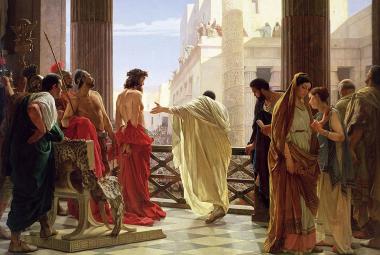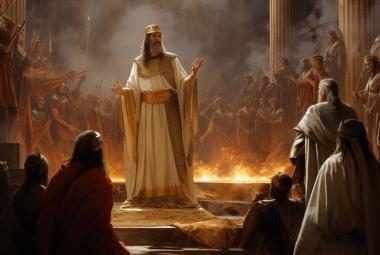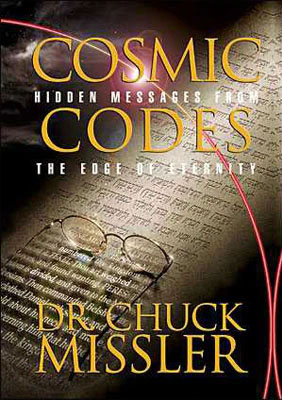As you undertake the serious study of the Bible, you are embarking on the most exciting adventure, the adventure of ideas. It should be your personal journey of discovery in this odyssey between the miracle of your origin and the mystery of your destiny.
Why an “adventure”? Because it isn’t a spectator sport; it involves participation! The most exciting “codes” will be the ones you discover for yourself. This is too important to be left to others. It’s the mystery of your personal destiny, after all. But there are some tools you may need to include for your journey.
Heretical Hermeneutics
Hermeneutics is the art of interpreting literature, especially the Sacred Scriptures, and it includes the recognition of the principles upon which a true analysis must proceed. It is to be distinguished from exegesis, which focuses on what the text actually expresses or intends to express.
(Many commentators tend to be like Humpty Dumpty in Lewis Carroll’s Through the Looking Glass, who maintained that, “When I use a word, it means just what I choose it to mean—neither more nor less.”1)
The classical approach to conservative Biblical hermeneutics usually emphasizes the following considerations.
- The consideration of the purpose of the Bible as a whole;
- The distinctive character of each book under consideration;
- To whom a specific passage is addressed;
- Exegesis: discovery of the exact meaning of the determinative words in the text (yet being alert to synecdoches, puns, et al.; see Cosmic Codes, Appendix A);
- Consideration of the context;
- Consideration of the all related Scripture on the given theme;
- The necessity of blindfolding your personal prejudices.
These emphases yield good intellectual hygiene. They are the pillars upon which traditional doctrines are rigorously anchored. It is the unwavering enslavement to the grip of context, however, that can seem myopic at times.
Developing a suitable balance of creative reach, constrained by scholarly caution, is essential in addressing any serious work and certainly is a primary challenge with respect to any Biblical investigation. (Yet this may be where you may need to exchange your straitjacket for a flak vest!)
Tools of Discovery
The tools of the trial lawyer are quite different from those of the detective. The former are deductive; the latter are inductive. The seminary graduate, defending a doctrine, uses much more restrictive techniques than the inquisitive student who is simply seeking understanding. Proofs are based on deductive reasoning. “Seek the normal sense, seek no other sense, or else you will get nonsense,” is the traditional and secure advice.
But before any final, rigorous proof is formulated, many rehearsals take place, and in these it is not deductive reasoning but plausible reasoning that is practiced. Deductive reasoning becomes useful only when we know what to prove and how to prove it. Plausible reasoning is the logic of discovery. The methods of plausible reasoning include induction, analogy, generalization and specialization.2
As we examine carefully the use of passages as they are “decoded” by the Scripture itself, however, we find some disturbing but illuminating examples. It will become apparent that it is the integrity of the whole that provides the ultimate context which often transcends the local context entirely.
Noncontextual Allusions
When Joseph and Mary were warned of Herod’s malicious intentions toward the baby Jesus, they fled to Egypt to escape his schemes.3 After Herod’s death, they were then free to return to their native Nazareth.4 In Matthew’s account, he specifically notes that the detour in Egypt was itself a fulfillment of a prophecy by Hosea:5
“Out of Egypt I have called my son.”
This appears to be a quote from Hosea 11:1, and yet when examined in its place, this application would appear to be extremely remote from the context one would infer from the source passage. Any attempt by Matthew to impute the constraints of the apparent context in Hosea seems contrived, indeed.
And again, in regard to the murder of the children in Bethlehem, Matthew draws upon a passage from Jeremiah as a prophecy being fulfilled:
“In Rama was there a voice heard, lamentation, and weeping, and great mourning, Rachel weeping for her children, and would not be comforted, because they are not.”
Matthew 2:18
This is taken from Jeremiah 31:15, which clearly has in view the return of the nation after the Babylonian exile. It is hard to see how the “context” has any bearing on the validity of Matthew’s application to the murders in Bethlehem.
In Chapter 16 [of Cosmic Codes] we reviewed a number of well-known prophecies that seem to emerge from the text despite the specific context that surrounded many of them. Paul, also, draws on some interesting “decodings” when he links, in 1 Corinthians 10:4, the concept of the “rock that followed” Israel in the wilderness to Jesus Christ Himself. He appears to be alluding to the two occasions during which they were provided their needed water to drink from the rock at Meribah.
From Paul’s clue, we can recognize a broader macrocode-type pattern in these two incidents. In fact, this broader perspective may clear up a mystery. In the first instance (Exodus 17:5-6), God instructed Moses specifically to strike the rock, which he did, and the water was then provided.
In the second instance (Numbers 20:7-11), God instructed Moses to speak to the rock.6 However, Moses, in his exasperation with his own people, struck the rock with his rod as he did on the previous occasion. What makes this situation so disturbing is that for Moses’ failure to follow God’s instructions precisely he was not allowed to enter the Promised Land! 7 He was allowed to view it from Mount Nebo before his death but not allowed to accompany his charges during their entry. What a blow!
It is generally taught that Moses simply misrepresented God to the people in letting them think that God was angry; and, perhaps, also appearing to take credit for the provision.8 In any case, this strikes many as a bit severe. After 40 years of faithful, strenuous, and often frustrating service, this misfeasance denied him his lifetime dream.
But there is also an additional possibility. If Moses had followed God’s specific instruction, these two events might have served as a macrocode of the two comings of the Messiah, in which only the first occasion involved the rock being smitten. Paul reveals that, idiomatically, the “rock” was a code for Christ. Is it possible that one aspect of Moses’ unfortunate performance was that an intended macrocode was thus blown?
Expositional Constancy
It is remarkable how consistent is the use of such metaphors and similes across the entire body of Scripture. It is one of the subtle, yet conspicuous, demonstrations of its unified design and its sole authorship. The “rock” allusion by Paul is echoed in similar phrases throughout the entire Bible as the Rock of our salvation,9 a rock of offense and stone of stumbling,10 and the very foundation (“upon this rock I will build my church”),11 each referring to Christ. This same “stone,”
“The stone which the builders refused is become the head stone of the corner.”
Psalm 118:22
This is quoted in Matthew 21:42, Mark 12:10, Luke 20:17, Acts 4:11, Ephesians 2:20, and 1 Peter 2:7, in each case referring to Jesus Christ Himself being the Chief cornerstone. Also,
“And he shall be for a sanctuary; but for a stone of stumbling and for a rock of offence to both the houses of Israel, for a gin and for a snare to the inhabitants of Jerusalem.”
Isaiah 8:14
This is quoted in 1 Peter 2:8, referring to Jesus Christ. And,
“Therefore thus saith the Lord GOD, Behold, I lay in Zion for a foundation a stone, a tried stone, a precious corner stone, a sure foundation: he that believeth shall not panic.”
Isaiah 28:16
This is quoted in 1 Peter 2:6 likewise. In the famous prophetic passage of Gentile dominion, we again see the “stone” idiom referring to Christ:
“Thou sawest till that a stone was cut out without hands, which smote the image upon his feet that were of iron and clay, and brake them to pieces.
“Then was the iron, the clay, the brass, the silver, and the gold, broken to pieces together, and became like the chaff of the summer threshingfloors; and the wind carried them away, that no place was found for them: and the stone that smote the image became a great mountain, and filled the whole earth.”
Daniel 2:34-35
This same idiom is quoted in Matthew 21:44 and Luke 20:18:
“And whosoever shall fall on this stone shall be broken: but on whomsoever it shall fall, it will grind him to powder.”
There are many other examples.
Hidden Keys to Unlock
Often the keys to unlocking a passage are tucked away in the strangest places. Local context is not always helpful in uncovering their implications. This is why it is such an incredible discovery to grasp the integrity of the entire collection—66 books that are an integrated message system. Once you discover that for yourself, innumerable difficulties disappear.
In Revelation chapter 9 we encounter strange “locusts” that have a king named Abaddon.12 Yet, Proverbs 30:27 tells us that the “locusts have no king.” Thus, we infer that the “locusts” of Revelation are not natural locusts but are idiomatic for demons. This same “code” is used in Amos 7:1 (in the Greek Septuagint) in which we learn that “Gog” is also a king of the demon locusts.13
There are hundreds of such subtleties that are too specialized for this overview and are best discussed within an expositional commentary of the specific passages involved.14
Pot Holes, Pitfalls, and Quicksand
Once you discover the integrity of the whole, and who Jesus Christ really is, it is amazing how many controversies evaporate…and how much pseudo-scholarship can be dispensed with. Here are just a few to make your trip less troublesome.
Pitfall No. 1: The Documentary Hypothesis
There are those who do not believe that Moses wrote the first five books of the Bible, the Torah (in Hebrew) or the Pentateuch (in Greek). Many academics espouse what is known as the “Documentary hypothesis” (also called the “Graf-Wellhausen” hypothesis), which was first popularized by Julius Wellhausen (1876-77) and his colleagues. Discerning what they felt were textual style differences, they attributed various segments of the books of Moses to various redactors known as J, or Yahwist; E, or Elohist; D, for a Deuteronomic source; P, for a Priestly source, etc.
Wading through the erudite details can make this all seem quite scholarly, but it is simply skepticism draped in academic arrogance. And it makes Jesus a liar or deceiver.
In one of His first endeavors after His resurrection, Jesus gave a seven-mile, Old Testament Bible study on the road to Emmaus in which He attributed the Torah to Moses.15 Throughout the New Testament, the Torah is quoted and invariably attributed to Moses.16 And Jesus clearly declared they all speak of Himself.17 The New Testament relies heavily on the Torah, with 165 direct quotes and over 200 allusions. To deny the authorship of Moses is to build the New Testament record on a foundation of deceit.
Any sound commentary on Genesis will deal with this distraction.
Pitfall No. 2: The Deutero-Isaiah Hypothesis
A close cousin to the Documentary Hypothesis is the notion that there were really two Isaiahs. (Some variants even suggest three or more.) This emerges from a perceived difference in style between the first 39 chapters and the last 27. It is purported that the writer of “Isaiah I” and the writer of “Isaiah II” lived at different times and had different styles.
Each of the detailed assertions can be refuted by sound textual analysis, but this can derail you from a great deal of more fruitful study. Again, the Scripture itself comes to our rescue. (It’s really amazing how the Scripture anticipates every heresy that has emerged throughout history.)
In John 12:38 there is a quote from Isaiah chapter 53. In John 12:40 there is a quote from Isaiah chapter 6. Between these two verses, John 12:39 links them by saying, “that [same] Isaiah said again.…” John tells us that Isaiah I and Isaiah II are by the same author. If you recognize the integrity of the whole, you can keep from wasting a lot of energy going down the rabbit trails of the skeptical academics.
Pitfall No. 3: Arguments from Church History
If anyone sets out to take the Bible seriously, it can be treacherous to rely on the vagaries of church history as a reliable guide. The entire history of the church has been a chronicle of repeated deviations from the clear teachings of the Scripture and, ultimately, their eventual correction. In fact, the seven letters to the representative churches in Revelation chapters 2 and 3 caught all of them off guard. Each church was surprised to read its report card.
A stellar example is the issue of amillennialism: the denial that Christ is literally to return to the earth to rule on David’s throne. This is still commonly taught in many churches. (I apologize if this appears offensive; but if one takes the Bible seriously, one has to deal with what the Bible says, not what denominational traditions have clung to.)
The Old Testament clearly taught that the Messiah would rule on David’s throne. These promises were reconfirmed to Mary in Luke 1:32. David’s throne did not exist during Christ’s ministry. This is clearly yet future. But the issue is much broader than that.
When the Roman Empire adopted Christianity under Constantine in the fourth century, the emphasis that Christ was to ultimately return to rid the earth of its evil rulers was not a popular pulpit position for the Imperial leadership. The allegorization of the Scriptures was then resorted to in order to “spiritualize” the message into more politically correct terms. Amillennialism, the denial of a literal future 1000-year rule of Christ on the earth, began with Augustine (A.D. 345-430), built upon the allegorizations of Origen.
However, amillennialism would make God guilty of not keeping His unconditional covenants to the physical descendants of Abraham, Isaac, and Jacob: the Jews.
- Promise of the land: Genesis 12:7; 13:15, 16; 17:7, 8.
- Promise of the land, a kingdom, and a greater Son of David (Messiah) as King: Psalm 89:27-37.
- Promise of restoration to the land of Israel from worldwide dispersion and the establishment of Messiah’s kingdom: Jeremiah 31:37; Ezekiel 36, 37, 38, 39, etc.
- Promises that a remnant of the Israelites will be saved: Romans 11:25-29; Zechariah 13:8,9; Isaiah 10:20-22.
When Augustine adopted the amillennial view, it became the dominant view of the Roman Catholic Church. Even after the Reformation, most of the Protestant reformers failed to challenge these views from the medieval church, and so they continue in many traditional denominations.
Amillennialism became a foundation for anti-Semitism (Jeremiah 31:35-37). Unfortunately, it is reviving again. It has, of course, proven tragic for the Jews. It has also proven tragic for the Church since it caused the Church to lose its Jewish roots and comprehension of the critical Old Testament perspectives.
There are many other ramifications that go far beyond this cursory review, and none of them is free of controversy. But this example was included as it is a conspicuous case where the Biblical text is quite clear and unambiguous, and yet church history has not proven to be a reliable guide to sound hermeneutics. There are many other examples, but we’ll let this caution flag suffice.
Beginning a Serious Study
The best way to eat an elephant is one bite at a time. Pick a book of the Bible—any book will do—and really dig into it.
Many like to start with the Gospel of John. It is said to be “Shallow enough for a child to wade in, deep enough for an elephant to immerse in.”
Others like to begin at the beginning, Genesis, especially with a good scientific commentary as an aid.
My favorite place to start newcomers is in the Book of Revelation. Really. It is the only book with a special promise to the reader. Review Chapter 19 for a lot of reasons that this is good place to start for the serious student. Then go to Genesis after completing Revelation.
Strangely, it doesn’t matter. Jump in and see for yourself.
Resources
In preparing for any adventure, it is important to pack the right tools. And it is good to have a guide who’s “been there.” Any good Christian bookstore will have a selection of expositional commentaries that will be helpful. You will quickly develop your own favorites.
A good study Bible is also a good place to start. There are many excellent ones available. Look them over. Pick one, and wear it out.
Another of the most indispensable tools is an exhaustive concordance, like the Strong’s. With it you can find any verse you might be looking for; you can find out for any word which Hebrew or Greek word it was translated from and what it means—without having to know the languages. It is not expensive and will quickly help you find anything you’re looking for.
If you have a computer and are on the Internet, you have enormous resources available, and they are free. You will want to discover the “Blue Letter Bible,” which is a completely hypertexted Bible, with Hebrew and Greek also available; several Bible dictionaries and encyclopedias, all word-searchable; complete cross references, etc. Also, you can “click” on any verse and it will make available dozens of commentaries—classic and contemporary—in text or audio, and all of this is free. Drop in on www.khouse.org and take a look.
On Your Own
We called this chapter, “Your Personal Adventure.” Why an “adventure”? Because it isn’t a spectator sport; it involves participation! The most exciting “codes” will be the ones you discover for yourself.
One of the most important protections against error (and heresy) is to maintain a view of the broadest context possible—“the whole counsel of God.” It all fits into a carefully designed whole. No part is trivial. And there are no contradictions. When you think you have found one, remember that God always rewards the diligent. Search it out carefully and it will result in a discovery.
It is essential to remember that this is a spiritual exercise, not simply an intellectual one.18 A man may admire a sundial; he may admire the cleverness of its design and adornments. But if he holds a lamp in his hand or any other light emanating from himself or from this world, he can make it any hour he pleases and will never be able to tell the time of day. Nothing but the light from God’s sun in the heavens can reckon it properly. In fact, the most startling discovery is that the Author of the Book stands ready to transcend the barriers of space-time to tutor you personally!
Sound crazy? I challenge you to give it a try. But you should keep a careful record so that you can tell where you have been and how you got there.
Your Private Log Book
Have you ever come across a passage in the Bible that you didn’t understand? Of course. We all have, many times.
There are times when it is essential to stop and track down the background, search supplemental references, etc., and not let the matter go undealt with. Other times it is more fruitful to note it but keep moving so as to not get bogged down in tangential issues.
I have a personal suggestion that may sound strange, but I believe you will find it a life-changing discovery. How would you like to conduct an empirical experiment in the supernatural? I mean a Biblical one, of course. In fact, this will be sort of a “laboratory” experiment in study methods.
Go to a stationery store and obtain a “journal,” a bound book with lined, but blank, pages—the kind intended for a personal diary or the like. (Girls know exactly what I am talking about; most fellows probably haven’t ever indulged in one.)
This will be for your eyes only. The commitment is that you will never show this to anyone else. (This is simply to ensure candor and intimate openness in compiling this very personal record. This will be very private and not intended for sharing.)
Step One
The next time you come across a passage that you don’t understand, or one that confuses you, open your journal and note the date, the reference that is puzzling, and—this is the hard part—try to describe your “confusion” over the passage in question. Try to express—to yourself, but in writing—why it doesn’t seem to make sense or appears contradictory, etc.
Step Two
Now close your journal and take advantage of your 24-hour “hotline” to the Throne Room of the Universe. Seek clarification from the Author Himself. Pray to our Father about it. God has promised to answer our prayers, particularly where His Word is concerned. He even has put His Word above His Name!19
“But the Comforter, which is the Holy Ghost, whom the Father will send in my name, he shall teach you all things, and bring all things to your remembrance, whatsoever I have said unto you.”
John 14:26
He has also promised to send the Holy Spirit to “teach us all things”20—not just most of them, but all things. He is a God who makes—and keeps—His promises! Put the problem in His lap. It is always exciting to see what happens then!
Step Three
Now note carefully what will happen next. It may not be in the next 60 seconds. It may be tomorrow, or maybe next week, whenever. But something will happen. You will have an encounter which will be a response to your specific petition.
The answer may come from some other passage which you are reading in your devotional studies. It may come from the next Sunday’s sermon, or a session in a neighborhood home Bible study. Or, it may come from some audio you happen to be listening to a few days later. It may be from something on the radio. Or even a conversation overheard in a restaurant, even one misunderstood; who knows?
But something will happen in your life to clarify and illuminate the problem passage!
Step Four
The previously confusing passage will now become so clear—and that’s part of the difficulty: you will have trouble remembering how confused you were about it earlier. That’s where your log book comes in.
So now you are to open your journal to the appropriate page, enter the date and the means by which your plea was answered, and then highlight your new insights which appear in contrast to your original entry.
Why Bother?
Why go through this little exercise? Why all the “paper work”?
This logging effort will develop into a unique treasure for yourself. Your journal will, frankly, be virtually meaningless to anyone else; it’s your own private turf. But to you, it will continue to grow more precious with each entry.
The days will come when you will be “down.” There will be times when you will go through your “Valley of Doubt.” There will be times when you will feel that it all seems so distant; that all of this seems so remote, or intangible. Maybe we have just gotten carried away with it all…
You will also discover that you are involved in an unseen warfare and there are spiritual forces that seek to separate you from truth, who will work to undermine your faith and inhibit your progress. There are sentient, malevolent, powerful beings who are your unseen adversaries. Their primary weapons seed doubt, deceit, and denial.21
When these doubts arise, and they will, you will then be able to go back to your private journal and review the numerous occasions when God the Holy Spirit Himself personally tutored you as you progressed through God’s Word. Each entry in your personal journal will be one of His “footprints” where He carried you along during your grand adventure.
Not only are you in possession of a message of extraterrestrial origin, the Sender is concerned for you personally and is available for counseling and guidance.
Hopefully this book22 has been useful in developing a new perspective of the very Word of God. It is a love letter, written in blood, on a wooden cross that was erected in Judea almost 2,000 years ago.
But the tomb is empty. He is risen, and has an agenda for you.
“For I know the plans I have for you, says the LORD, plans for your welfare and not for evil, to give you a future and a hope.”
Jeremiah 29:11
And He is waiting to hear from you.
Suggestions for further reading:
Some additional resources available from this publisher:
- Chuck Missler, How to Study the Bible, a briefing package consisting of two one hour sessions, including notes and references highlighting the experiences of a 40-year love affair with the Word of God.
- Also, A Walk Thru the Bible, a briefing package which attempts—within two 90-minute sessions—to provide a strategic grasp of the whole Bible, as an adjunct to the specific exploration of any particular book.
- Koinonia House publications
- Koinonia House Store
- Koinonia Institute, online study courses, free enrollment.
This article was excerpted is from Dr. Chuck Missler’s book Cosmic Codes, available from our online store https://store.khouse.org. Also available as an 8 hour audio presentation.
NEW! Watch a previously unreleased video of Chuck presenting a summary of Cosmic Codes free on our YouTube channel here...
Notes:
1 Charles Lutwidge Dodgson, (as Lewis Carroll), Through the Looking Glass and What Alice Found There, acmillan & Co.,New York, 1871.
2 G. Polya, Patterns of Plausible Inference, Vol. II of Mathematics and Plausible Reasoning, Princeton University Press, Princeton, New Jersey, 1954.
3 Matthew 2:13, 14.
4 Matthew 2:19-23.
5 Matthew 2:15.
6 Number 20:8.
7 Numbers 20:12; Deuteronomy 34:4.
8 Numbers 20:10.
9 Deuteronomy 32; 2 Samuel 22:2, 3, 32, 47; Psalm 18:31, 46; 95:1; et al.
10 Isaiah 8:14; Romans 9:33; 1 Peter 2:8.
11 Matthew 16:18.
12 Revelation 9:11.
13 The Septuagint (much older than the Masoretic from which our English is taken) reads that “one of the devastating locusts was Gog their king.” This clears up a number of mysteries concerning the leader Gog of the land of Magog of Ezekiel 38. See The Magog Invasion from this publisher.
14 Expositional commentaries by the author, as audio and/or video, and accompanied with extensive notes, charts and references, are available from the publisher.
15 Luke 24:27.
16 Matthew 8:4; 19:7, 8; 23:2; Mark 1:44; 10:3, 4; 7:10; Luke 5:14; 16:19, 31; 20:37; 24:27, 44; John 3:14; 5:39, 45, 46; 6:32; 7:19, 22, 23.
17 John 5:39; Psalm 40:7; Matthew 5:17,18.
18 1 Corinthians 2:1-16.
19 Psalm 138:2.
20 John 14:26.
21 Ephesians 6:10-18.







